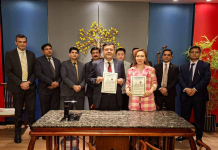BEIJING: China’s economy delivered a solid performance in the first half of 2025, with robust growth across the manufacturing sector, high-tech industries, and domestic consumption, according to the latest data from the State Taxation Administration. The strong showing comes as government policy measures continue to yield results, and multiple departments have recently outlined key priorities for the second half of the year.
Data shows that the sales revenue of manufacturing enterprises grew 1.5 percentage points faster than that of all enterprises nationwide, while sales revenue in high-tech industries recorded a rapid growth of by 14.3 percent year-on-year. Driven by policies promoting large-scale equipment upgrades and trade-ins of consumer goods, corporate spending on mechanical equipment increased by 11.1 percent. Meanwhile, sales revenue of audio-visual products and home appliances surged by 45.3 and 56.6 percent, respectively.
To build on the momentum, government departments have mapped out their key priorities for the second half of the year, highlighting three core themes: unlocking the potential of domestic demand, promoting tech–industry integration, and strengthening overcapacity management in key sectors.
The National Development and Reform Commission (NDRC), China’s top economic planner, said another 69 billion yuan ($9.65 billion) in ultra-long special treasury bond funds will be allocated in October to support the consumer goods trade-in program.
Finance Minister Lan Fo’an, in a recent article, announced that new interest subsidy policies will soon be introduced to support consumer loans in priority areas, along with financial assistance for service-sector businesses.
In a bid to foster new growth drivers for consumption, the Ministry of Industry and Information Technology (MIIT) said it will roll out an action plan to boost demand by improving the alignment between supply and consumer preferences.
On the innovation front, the MIIT emphasized on implementation of the major national science and technology initiatives, the expansion of innovation platforms, and the cultivation of technology business incubators.
It also called for further improvement of industrial development policies on humanoid robotics, the Internet of Things, and high-end instrumentation. –The Daily Mail-CGTN news exchange item






